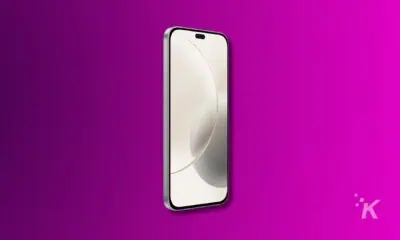Android
Review: Assault Android Cactus (Nintendo Switch) – Outstanding twin-stick joy
Assault Android Cactus is for anyone who loves twin-stick shooters.

Just a heads up, if you buy something through our links, we may get a small share of the sale. It’s one of the ways we keep the lights on here. Click here for more.
[letsreview postid=”87292″]
The hardest thing about writing this review for Assault Android Cactus is that I have to stop playing Assault Android Cactus to write it. The second hardest part about writing this review is that I have to come up with critiques of this game, for which I find myself utterly grasping at straws.
Assault Android Cactus is a twin-stick shooter of the caliber you don’t see often and the version for Switch is the definitive experience for it.
The most succinct way I can summarize this game is this: Assault Android Cactus is a twin-stick shooter that does everything right. In it, you control one of several characters from a cast of misfit androids and you go up against a rogue AI that’s taken control of a cargo ship and all of its non-android mechanized crew.
Each character has a unique personality, manifest in their weapon loadout, appearance, voice, and unique dialogue throughout the game. You start out with a handful and unlock someone new after each world, which consists of several levels and a boss.

Screenshot: Jacob Vander Ende / Know Techie
Assault Android Cactus is a twin-stick shooter that does everything right.
During the game, the mechanics are straightforward. It’s a twin-stick shooter, so the left stick moves you around, the right stick aims, the right triggers are both fire buttons, and the left triggers are both weapon-swap buttons (you can use either trigger; they do the same thing). Your battery is both your arcade-style timer and your health bar and you pick up recharge batteries in the level from key enemies or from critical boss moments like phase changes.
There are also temporary power-ups that gives you boosted speed and evasion, supplemental firepower sidekicks, and an EMP pulse that shuts down every opponent on-screen.

One of the levels turns the lights out on you and gives you a flashlight, which is how you learn that all of the enemies have unique glowing parts to them. Assault Android Cactus is filled with this level of detailed polish. (Image: Jacob Vander Ende / KnowTechie)
All of this is pretty standard fare for twin-stick gameplay, but Assault Android Cactus shines in the fact that it does everything well. Every character feels unique, from the feel of their weapons to the way they talk. Cactus, for instance, is a loose cannon, aloof security officer, while Holly is a timid bookkeeper. Starch, on the other hand, clearly has a few glitches and shouts things like “Tiny robots!” when you pick up firepower or “Last time I had this much fun I got deactivated!” when you hit a long combo streak.
It’s incredibly rare that I play a twin-stick shooter and don’t immediately pick a favorite, but I really can’t in this game. I love the continuous fire laser and personality of Starch, but Coral’s shotgun and vaporizing sphere of death secondary are great, too, and I’d be remiss if I didn’t mention Aubergine’s incredible buzz saws that you move around by holding and releasing the fire button. As a developer myself, I know that you balance something by making everything cool and appealing and this is something Assault Android Cactus does extremely well.
…you balance something by making everything cool and appealing and this is something Assault Android Cactus does extremely well.

Image: Jacob Vander Ende

Notice how the exact same boss has different dialogue for every character. (Image: Jacob Vander Ende)
Beyond that, this version of Assault Android Cactus really goes the extra mile in every way. There’s a 99% Invisible episode called “Curb Cuts” that I really adore and it’s all about accessible design. In it, they talk about how a small group of wheelchair users worked and worked and eventually got New York City to implement curb cuts all over the city, a phenomenon that spread to other major cities fairly rapidly. You know what I’m talking about: curb cuts are those little ramps that go from sidewalk level to street level.
The idea is that accessibility benefits everyone. Curb cuts are useful for people in wheelchairs, but they’re also useful for anyone with luggage, people using hand carts to load or unload trucks, small children, and tons of other folks outside of the original intended demographic. What do curb cuts have to do with a twin stick shooter?
I really love this trend of difficulty as an accessibility metric, I love how it’s implemented in Assault Android Cactus, and I hope other games follow suit.
Assault Android Cactus implements this ideology beautifully with its accessibility options. They have a new one for the Switch version, for instance, that uses intelligent auto-aim as a toggle option. It’s intended for people who aren’t used to twin-stick shooters and only want to focus on moving and shooting, but I tried it out and even as a twin-stick veteran I found it to be wonderful.
The Switch isn’t really designed for twin-stick controls and my hands cramp up pretty quickly but using auto-aim let me take breaks and give my hand some much-needed rest. There are other accessibility options, too, like color scheme settings, but I really love this trend of difficulty as an accessibility metric, I love how it’s implemented in Assault Android Cactus, and I hope other games follow suit.

This screenshot doesn’t do Aubergine justice, but that red circle is actually a whirling blade of death. It becomes dramatically easier to control when using Assault Android Cactus’s new accessibility options. (Image: Jacob Vander Ende)
Now, this is where I have to admit that I didn’t actually get to beat Assault Android Cactus for this particular review. I beat it a few years ago when it debuted on PS4, to be fair, but this time around there’s just so much to explore that it’s almost daunting. The main campaign is several worlds long and you could probably beat it in a day or two if you’re especially skilled, play all day, and your hands don’t get tired. Outside of that, there’s developer commentary, so maybe you want to go back and hear explanations about all the levels, which I highly recommend.
I didn’t know, for instance, that when you switch weapons you also get a brief invulnerability window that lets you dodge attacks. There’s also a daily challenge run, an infinite levels mode, a campaign+ mode I didn’t even get to see, multiplayer, a sound test, a jukebox with the game’s entire soundtrack, a concept and fan art gallery, and on and on and one.
Did I mention that there’s even a first-person mode where you can play Assault Android Cactus as a first-person shooter? That’s in here too, along with about a dozen other extra options reminiscent of the kind of over-the-top, joyous nonsense pioneered by games like Goldeneye on N64. Assault Android Cactus is simultaneously concise and enormous.

I literally howled, “ARE YOU KIDDING ME?” when I unlocked this extra mode. It isn’t ham-fisted, either; first-person mode is actually a ton of fun. (Image: Jake Vander Ende / KnowTechie)
Literally, my only complaint about Assault Android Cactus is that they don’t explicitly teach you that you can dodge by swapping weapons. I originally beat the game without that knowledge, which was ludicrously hard, and it feels bad that I had to learn about it through developer commentary. Outside of that, I really can’t say anything bad about this game. Assault Android Cactus is everything I want in a twin-stick shooter.
Assault Android Cactus is everything I want in a twin-stick shooter.
It should be pretty clear by this point that I’m giving Assault Android Cactus a 10 out of 10. I beat this game years ago and playing it anew on Nintendo Switch still blows me away. Even as a veteran of twin-stick shooters and as someone working on one of my own, I still find Assault Android Cactus to be a game that sets the bar for everything else in the genre. The last time I played a twin-stick shooter this potent was Geometry Wars, and Assault Android Cactus easily warrants a place standing shoulder to shoulder with the genre titans like it.
Assault Android Cactus is for anyone who loves twin-stick shooters, from seasoned veterans to those new to the genre and looking for an entry that’s accessible.
Jake reviewed Assault Android Cactus for the Nintendo Switch with a review code from the developers, who he originally met at SXSW in 2015. He’s been dabbling in twin-stick shooter development for years and has yet to come up with anything as excellent as Assault Android Cactus. He lovingly shelves this game alongside genre favorites like Geometry Wars, Dead Nation, and Hotline Miami. He knows he said he couldn’t pick a favorite, but that was only to spare the feelings of all the androids not named Starch.
Editors’ Recommendations:
- Review: LOVE – Less is amour
- Games you should be playing in March (plus one you should probably avoid)
- The Nintendo Switch enters the world of VR with a new Labo kit
- PlayStation 4 Remote Play makes its way to the iPhone and iPad
- Bioware is releasing a patch next week to address Anthem PS4 crashes






























